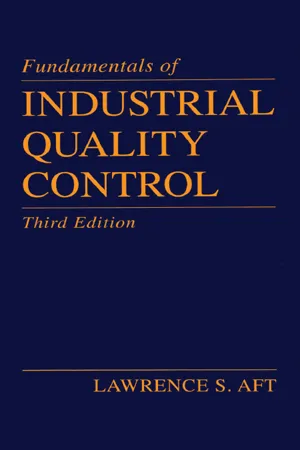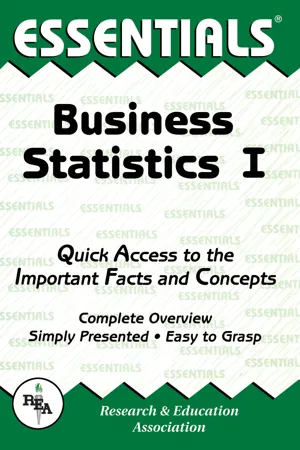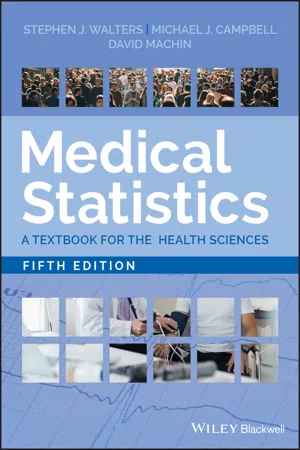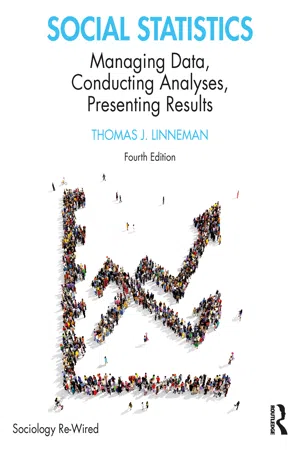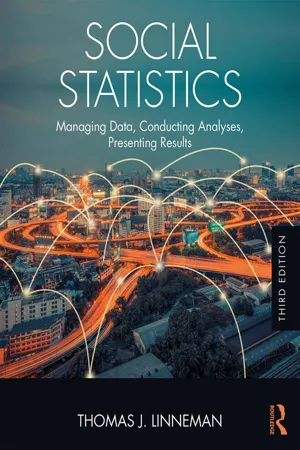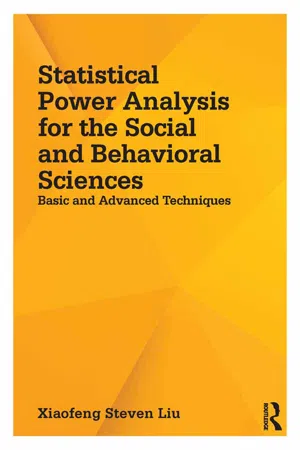Confidence Interval for Population Proportion
A confidence interval for a population proportion is a range of values within which we are reasonably confident the true population proportion lies. It is calculated using sample data and provides a measure of the uncertainty associated with estimating the population proportion. The confidence interval is often expressed as a percentage, such as 95% confidence.
8 Key excerpts on "Confidence Interval for Population Proportion"
- eBook - ePub
- Lawrence S. Aft(Author)
- 2018(Publication Date)
- CRC Press(Publisher)
...A 95 percent confidence interval would be even wider — for example, between 722.49 and 741.51.) A confidence interval is a range of values that has a specified likelihood of including the true value of a population parameter. It is calculated from sample calculations of the parameters. There are many types of population parameters for which confidence intervals can be established. Those important in quality control applications include means, proportions (percentages), and standard deviations. Confidence intervals are generally presented in the following format: Point estimate of the population parameter ± (Confidence factor) (Measure variability) (Adjusting factor) A number of formulas have been developed for particular cases. The remaining sections of this chapter will present, illustrate, and interpret these formulas as they relate to quality control. Confidence Intervals for Means The way a confidence interval for means is developed depends on the sample size. As noted earlier, the larger the sample size, the better the estimate. Statistically, large samples are arbitrarily defined as those with 30 or more members. Small samples have fewer than 30 members. Either a z value or a t value is needed to represent the level of significance in confidence interval formulas when one is dealing with averages. Other probability distributions are used when dealing with confidence intervals for other statistics, such as standard deviations. z Values For large samples, the standard normal curve is used to specify the confidence. The value corresponding to the confidence is the z value. Example 5.1 What z value corresponds to an α of.05 or 95 percent confidence? Solution We are looking at a confidence interval for which the area outside the interval is symmetrically distributed...
- eBook - ePub
- Louise Clark(Author)
- 2014(Publication Date)
- Research & Education Association(Publisher)
...After all, it is the value of Π which we are trying to estimate. Therefore, it is obvious that if we desire to estimate this value that it is unknown, we cannot possibly use an equation that requires the substitution of this unknown value. Thus, the equation for a confidence interval estimate for a proportion becomes: where: P = sample proportion (point estimate) Z = standard normal score = n = sample size Π = population proportion being estimated γ = likelihood that the population proportion will fall within the range established by confidence interval. EXAMPLE: A random sample of 100 employees was selected from all of the employees of the Federal Corp. in order to determine the percentage of employees who feel that improvements are needed in the supervisor/worker relationship. Of the 100 surveyed, 67 made this indication. Construct a 90% confidence interval. SOLUTION: 1. Determine if the normal distribution is appropriate for this problem: 2. Specify stated values: 3. Determine the appropriate value of Z using the Table of Areas Under the Standard Normal Curve. Z = ·1.645. 4. Calculate the confidence interval. 5. Interpret the results. We can be 90% confident that the proportion (percentage) of all those employed by the Federal Corp. who believe that improvements are needed in the supervisor/worker relationship is contained within the range of. 593 to.747 (59.3% to 74.7%). If the sample size is less than 50 when working with inferential procedures involving proportions, the proper distribution is the binomial distribution. These procedures are beyond the scope of this book. 6.3 DETERMINING THE SIZE OF THE SAMPLE We have previously illustrated a number of examples in which we “assumed” the sample to be a given size. However, in actual practice we do not just “pick” or “assume” a sample size...
- eBook - ePub
Medical Statistics
A Textbook for the Health Sciences
- Stephen J. Walters, Michael J. Campbell, David Machin(Authors)
- 2020(Publication Date)
- Wiley-Blackwell(Publisher)
...However, most statisticians, including us, often describe confidence intervals in that way. The value of 0.95 is really the probability that the limits calculated from a random sample, of size 98 from a population of premature babies, will include the population value. For 95% of the calculated confidence intervals it will be true to say that the population mean, μ, lies within this interval. The problem is, as Figure 5.6 shows, with a single study we just do not know which one of these 100 intervals in Figure 5.6 we will obtain and hence we will not know if it includes μ. So, we usually interpret a confidence interval as the range of values within which we are 95% confident that the true population mean lies. Confidence Interval for a Proportion Since a proportion, p, is a mean of a series of 0s and 1s, we can use a similar expression for a confidence interval for π as we did for μ with corresponding changes to the estimated parameter and the associated standard error. The Central Limit Theorem will assure Normality. The standard error is given in Table 5. 2 and so the confidence interval is just the estimate ± 1.96 × SE once more. Table 5.3 Population parameters of the Normal, Binomial and Poisson distributions, their estimates and the associated standard errors (SE) for comparing two groups. Distribution Parameter Population value Estimated difference SE (difference) Normal Mean μ 1 – μ 2 Binomial Proportion π 1 – π 2 p 1 – p 2 Poisson Rate λ 1 – λ 2 r 1 – r 2 Source: data from Brown et al. 2016. Example from the Literature – Confidence Interval for a Proportion –Gastrostomy in Patients with Amyotrophic Lateral Sclerosis (ProGas) The ProGas study reported that 12 patients out of 330 died within the first 30 days after a gastrostomy giving the death rate as p = 12/330 = 0.036, SE(p) = 0.016 and a 95% confidence interval for π as...
- eBook - ePub
- Mustapha Abiodun Akinkunmi(Author)
- 2019(Publication Date)
- De Gruyter(Publisher)
...9 Confidence Intervals for Single Population Mean and Proportion When a statistic is computed from sample data to estimate a population parameter, we have to reduce our risk of estimation by constructing a range in which the exact value of the population parameter lies. This is due to the variability in the sample collected. This process gives us the assurance within a certain percentage that the estimate is capable of predicting the real value of the population of interest. This concept describes the confidence interval or confidence limit. In this chapter, we focus on constructing the confidence interval for both mean and proportion. 9.1 Point Estimates and Interval Estimates When a sample is drawn from a population, a single attribute obtained or quality computed from the measurement is called a statistic. When this statistic closely describes the characteristics obtained from the population, the estimate or a single value from the sampled data is referred to as a point estimate. For example, a human resource manager may want to assess the productivity of workers in a firm. The number of cases closed per month can be used as a metric to measure productivity. It is discovered that the average number of cases closed per month was 22—thus the value 22 is the point estimate. On the other hand, in order to know how well a sample statistic accurately describes a population, we can compute a range of values within which we are confident enough to say the true value of population parameter lies. The interval estimate offers a measure of exactness beyond that of the point estimate by giving an interval that contains plausible values. In most cases, we use a 95% confident limit for the estimation—this implies that we can say that our estimation about a population plausibly falls within the specified range of values in 95 out of 100 cases. For instance, a researcher may like to know the number of cars traveling a road on a daily basis...
- eBook - ePub
- Michael Smithson(Author)
- 2002(Publication Date)
- SAGE Publications, Inc(Publisher)
...An unbiased confidence interval is one whose probability of including any value other than the parameter’s true value is less than or equal to 100(1 – α)%. As a brief illustration, consider the normal approximation of a confidence interval for the proportion. It is not difficult to demonstrate that for high confidence levels, the shortest 100(1 – α)% confidence interval is one that allocates α/2 to the lower limit and to the upper limit. If we allocate α/2 + γ to the lower limit, for example, then we must distribute α/2 – γ to the upper limit. The lower limit will be shifted by a greater amount than the upper limit if α/2 is small, because in that region the normal curve steepens as we move toward the mean. For example, a 95% confidence interval with.025 allocated to each limit has a width of (z.025 + z.025)(s P) = (1.96 + 1.96)(s P) = 3.92(s P). A 95% interval with.04 allocated to the lower limit and.01 to the upper has a width of (z.04 + z.01)(s P) = (1.75 + 2.33)(s P) = 4.08(s P), and one with.0499 allocated to the lower limit and.0001 to the upper has a width of 5.37(s P). The third crucial choice concerns the confidence level. The 95% and 99% confidence levels are the most popular, but these simply reflect the popularity of the.05 and.01 Type I error rates in the significance testing tradition. The choice of confidence level is important because, all else being equal, the more confidence required, the wider the confidence interval. For a constant sample size and non-extreme values, confidence intervals for the proportion approximately double in width as we move from 75% to 99% in confidence level. The trade-off is between confidence and informativeness or decisiveness. A 100% confidence interval for the proportion from 0 to 1 is trivial because it is utterly uninformative. On the other hand, a 50% confidence interval is clearly too risky for most decision-making purposes regardless of the decisiveness it provides...
- eBook - ePub
Social Statistics
Managing Data, Conducting Analyses, Presenting Results
- Thomas J. Linneman(Author)
- 2021(Publication Date)
- Routledge(Publisher)
...This is because of the smaller sample size and the larger standard deviation, both of which lead to a larger standard error. Using the 95% confidence intervals, we can say that the two groups differ: the upper end of one confidence interval (28.21) does not overlap with the lower end of the other confidence interval (28.28). However, if we wanted to be more certain by using the 99% confidence intervals, we would conclude that it is feasible that the population means could be equal: the upper end of one confidence interval (28.44) overlaps with the lower end of the other confidence interval (27.72). Confidence Intervals With Proportions When I began talking about confidence intervals, the example used proportions: 56% of people preferred Candidate W. The proportion equivalent of a percentage of 56% is 0.56. But notice that, with this kind of result, there is no mean. Proportions have no means. However, we can still use the same confidence interval logic. All we need is a way to calculate the estimate of the standard error for a proportion (P), and we can do so with the following formula: e s t i m a t e o f σ p = P 1 − P n It rather resembles the formula for the standard error of the mean. The sample size is on the bottom, just like in the other formula. We don’t have the standard deviation on the top, but we can consider this “P (1 – P)” a measure of variation if you think about it (and, of course, I’m going to ask you to think about it). The P is the proportion, and the 1 – P is its complement. If you’re looking at the probability of something happening, the complement is simply the probability of it not happening. For example, if we used that 56% from earlier, P would be 0.56, meaning there’s a 56% chance that someone supported Candidate W. The complement, then, would be 1 – P : 1 – 0.56 = 0.44. There’s a 44% chance that someone did not support Candidate W...
- eBook - ePub
Social Statistics
Managing Data, Conducting Analyses, Presenting Results
- Thomas J. Linneman(Author)
- 2017(Publication Date)
- Routledge(Publisher)
...Chapter 5 Using a Sample Mean or Proportion to Talk About a Population Confidence Intervals This chapter covers.... . . building a probability distribution of sample means. . . how to find and interpret the standard error of a sampling distribution. . . what the Central Limit Theorem is and why it is important. . . population claims and how to put them to the test. . . how to build and interpret confidence intervals. . . how a researcher used confidence intervals to study popular films. . . how researchers used confidence intervals to study Uber and traffic fatalities Introduction In this chapter we continue our exploration of inference, going through some procedures that you will find strikingly similar to those in the chi-square chapter. Whereas in the chi-square chapter we dealt with variables of the nominal or ordinal variety, here we deal with ratio-level variables. Our attention turns away from sample crosstabs and toward sample means (and, at the end of the chapter, proportions). But keep in mind that the inference goal remains the same: we will use sample means in order to make claims about population means. Just as we talked about the chi-square probability distribution, we’ll start this chapter with a distribution of sample means. Sampling Distributions of Sample Means Imagine a hypothetical class with 100 students in it. These students will serve as our population: it is the entire group of students in which we are interested. They get the following hypothetical grades: ■ Exhibit 5.1: Grades for a Population of 100 Students: Frequency Distribution Grade # of Students Receiving This Grade 1.0 1 1.1 1 1.2 1 1.3 2 1.4 2 1.5 2 1.6 2 1.7 3 1.8 3 1.9 3 2.0 4 2.1 4 2.2 5 2.3 6 2.4 7 2.5 8 2.6 7 2.7 6 2.8 5 2.9 4 3.0 4 3.1 3 3.2 3 3.3 3 3.4 2 3.5 2 3.6 2 3.7 2 3.8 1 3.9 1 4.0 1 Source: Hypothetical data. Here is a bar graph of this frequency...
- eBook - ePub
Statistical Power Analysis for the Social and Behavioral Sciences
Basic and Advanced Techniques
- Xiaofeng Steven Liu(Author)
- 2013(Publication Date)
- Routledge(Publisher)
...Power of Confidence Interval DOI: 10.4324/9780203127698-3 There has been a recent movement to shift the emphasis from hypothesis testing to confidence interval (Cumming and Finch, 2001). The critics of hypothesis testing argue that a p -value does not suggest the size of the treatment effect and that non-statisticians confuse statistical significance with practical importance. Some journal editorials (International Committee of Medical Journal Editors, 1988 ; Wilkinson, 1999) have called directly for the use of confidence intervals in lieu of hypothesis tests. Although misconceptions about hypothesis testing are common, it will remain the main vehicle of research inquiry in the social sciences. Nevertheless, a confidence interval accompanying a hypothesis test is encouraged in research practice. The wide use of confidence intervals will not automatically improve statistical practice unless people pay attention to sample size and the precision of the confidence interval. A wide confidence interval is not informative about the true size of the parameter because such a confidence interval shows a wide range of plausible values that the parameter can take. For example, a confidence interval for the mean age on a university campus may indicate that the mean age is between 10 and 40 years old. Although the confidence interval is very likely correct, it does not offer useful information about the actual ages on the campus. The width of a confidence interval needs to be sufficiently narrow to be useful. Sample size plays an important role in achieving a narrow interval width. In the following, we will first describe the formation of a confidence interval and then explain the relationship between its width and sample size. 3.1 Sample Size and Confidence Interval in a z-test A confidence interval can be formed by extending a certain number of standard errors around a point estimate of the parameter...
